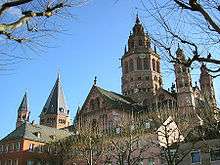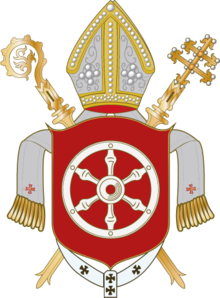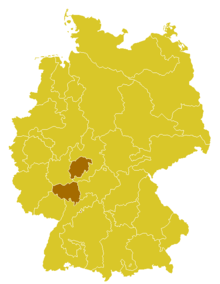Roman Catholic Diocese of Mainz
The Diocese of Mainz, historically known in English by its French name of Mayence is a Latin rite of the Catholic church in Germany. It was founded in 304, promoted in 780 to Metropolitan Archbishopric of Mainz and demoted back in 1802 to bishopric. The diocese is suffragan diocese in the ecclesiastical province of the Metropolitan Archdiocese of Freiburg.[1][2][3] Its district is located in the states of Rhineland-Palatinate and Hesse. The seat of the diocese is in Mainz at the Cathedral dedicated to Saints Martin and Stephen.[4] It is the only Roman Catholic diocese in the world – other than Rome – which bears the title of a Holy See.[5]
Diocese of Mainz Dioecesis Moguntinus Bistum Mainz | |
|---|---|
 Mainz Cathedral | |
 | |
| Location | |
| Country | |
| Ecclesiastical province | Freiburg |
| Metropolitan | Archdiocese of Freiburg |
| Statistics | |
| Area | 7,692 km2 (2,970 sq mi) |
| Population - Total - Catholics | (as of 2016) 2,899,491 742,165 (25.6%) |
| Information | |
| Denomination | Catholic |
| Sui iuris church | Latin Church |
| Rite | Roman Rite |
| Established | 4th Century |
| Cathedral | Mainz Cathedral |
| Patron saint | St. Martin of Tours |
| Current leadership | |
| Pope | Francis |
| Bishop | Peter Kohlgraf |
| Metropolitan Archbishop | Stephan Burger |
| Auxiliary Bishops | Udo Bentz |
| Vicar General | Udo Bentz |
| Bishops emeritus | Franziskus Eisenbach |
| Map | |
 | |
| Website | |
| bistummainz.de | |
History
- Established in 340 as Diocese of Mainz
- Gained territory in 755 from the suppressed Diocese of Erfurt
- Promoted in 780 as Metropolitan Archdiocese of Mainz
- Demoted (back) on the 29th of November, 1801 to Diocese of Mainz (gained territory from Diocese of Metz, Diocese of Speyer, Metropolitan Archdiocese of Trier and Diocese of Worms)
- Lost territories repeatedly; in April 1818 to Diocese of Konstanz, Diocese of Speyer and Diocese of Wurzburg; in July 1821 to Diocese of Paderborn; in August 1821 to Diocese of Fulda and to establish Diocese of Limburg, and exchanged territory with Diocese of Trier; in March 1824 to Diocese of Hildesheim.
Organization, extent and statistics
Under Article 14 of the Reichskonkordat of 1933, which remains in force, the determination of the bishop to head the episcopal see and the composition of the chapter are governed by the provisions of Baden Concordat of 1932.
As per 2014, it pastorally served 749,583 Catholics (25.9% of 2,891,000 total) on 7,692 km² in 319 parishes, 504 priests (409 diocesan, 95 religious), 124 deacons, 447 lay religious (132 brothers, 315 sisters), 19 seminarians.
It is divided into 20 deaneries, which in turn are divided into 136 pastoral care units. In 2007 these parish associations or parish groups included all 335 parishes and other chaplaincies of the diocese (as of 2007).[6] Pastoral units on the parish level have been introduced as a result of a profound structural change in the Catholic Church in Germany in many dioceses, the constitution of these units was determined by particular law [law of a particular region or territory], i.e., allowing for differences from one diocese to another. In the diocese of Mainz a parish group may be several parishes merged under the leadership of a single pastor. The parishes retain their church and state church legal personality. The pastor is attached to a pastoral team and a pastoral council. Parish associations, however, are combinations of several parishes, each with its own pastor. Several parish groups can join together to form a parochial associations.
Episcopal ordinaries
- Suffragan Bishops (again) of Mainz, 1802–present
- Joseph Ludwig Colmar (1802–1818)
- Joseph Vitus Burg (1829–1833)
- Johann Jakob Humann (1833–1834)
- Petrus Leopold Kaiser (1834–1848)
- Wilhelm Emmanuel Freiherr von Ketteler (1850–1877)
- Paul Leopold Haffner (1886–1899)
- Heinrich Brück (1900–1903)
- Georg Heinrich Kirstein (1903–1921)
- Ludwig Maria Hugo (1921–1935)
- Albert Stohr (1935–1961)
- Hermann Cardinal Volk (1962–1982)
- Karl Cardinal Lehmann (1983–2016)
- Peter Kohlgraf (2017– ...)
Auxiliary bishops
Archdiocese (to 1802)
- Hermann, O.F.M. (1405–1450)
- Hermann von Gehrden, O.P. (1432–1471)[7]
- Sigfried Piscator, O.P. (1446–1455) and (1462–1473)[8]
- Heinrich Hopfgarten, O.S.A. (1455–1460)[9]
- Heinrich von Rübenach, O.P. (1457–1493)[10]
- Johannes Schulte, O.S.A. (1466–1489)[11]
- Berthold von Oberg, O.P. (1468–1489)[12]
- Dionysius Part, O.P. (1474–1475)[13]
- Matthias Emich, O. Carm. (1476–1480)[14]
- Georg Fabri, O.P. (1490–1498)[15]
- Erhard von Redwitz, O. Cist. (1494–1502)[16]
- Johannes Bonemilch (1497–1508)[17]
- Thomas Ruscher (1502–1510)[18]
- Paul Huthen (1509–1532)[19]
- Johannes Münster (1511–1537)[20]
- Maternus Pistor (1534)[21]
- Michael Helding (1538–1550)[22]
- Georg Neumann (bishop) (1550–1551)
- Wolfgang Westermeyer (1551–1568)
- Balthasar Fannemann (Waneman) (1551–1561)
- Leonhard Zittardus, O.P. (1563–1569)
- Stephan Weber (1570–1622)
- Nikolaus Elgard (1577–1587)
- Valentin Mohr, O.S.B. (1606–1608)
- Cornelius Gobelius (1609–1611)
- Christoph Weber (1615–1633)
- Ambrosius Seibaeus (Seybeus) (1623–1644)
- Wolther Heinrich von Strevesdorff, O.E.S.A. (1634–1674)
- Berthold Nihus (1655–1657)
- Peter Walenburch (1658–1670)
- Johann Brassert (1674–1676)
- Adolph Gottfried Volusius (1676–1679)
- Johann Daniel von Gudenus (1680–1694)
- Matthias Starck (1681–1702)
- Johann Jakob Senfft (1695–1718)
- Johann Edmund Gedult von Jungenfeld (1703–1727)
- Johann Joachim Hahn (1718–1725)
- Christoph Ignaz von Gudenus (1726–1747)
- Caspar Adolph Schernauer (1728–Jun 1733)
- Christoph Nebel (1733–1769)
- Johann Friedrich von Lasser (1748–1769)
- Johann Georg Joseph von Eckart (1769–1792)
- Ludwig Philipp Behelm (1769–1777)
- August Franz von Strauß (Strauss) (1778–1782)
- Johann Valentin Heimes (1783–1806)
- Johann Maximilian von Haunold (1792–1807)
Diocese (1802–present)
- Joseph Maria Reuß (Reuss) (1954–1978)
- Wolfgang Rolly (1972–2003)
- Franziskus Eisenbach (1988–2002)
- Werner Guballa (2003–2012)
- Ulrich Neymeyr (2003–2014)
- Udo Markus Bentz (2015– )
Catholic Education
Catholic Private Schools
The most important educational institution of the Diocese is the Catholic University of Applied Sciences, Mainz. Besides the Roman Catholic Diocese of Mainz and the (arch)dioceses of Cologne, Limburg, Speyer and Trier belong to the initiators of this university . There are also other schools as the Edith-Stein-Schule in Darmstadt, Liebfrauenschule in Bensheim, the Episcopal Willigis-Gymnasium in Mainz, Abendgymnasium Ketteler of Mainz and the Episcopal College Willigis secondary school in Mainz.
Facilities at state universities
The diocese maintains three facilities at state universities. The most important of them is the Catholic Theological Faculty at the University of Mainz. In addition, there are at University of Giessen, the Institute for Catholic theology and their didactics, which is located at the Department of History and Cultural Studies. At the Technische Universität Darmstadt is an institute for theology and social ethics.
Bildungswerk der Diözese Mainz
The Bildungswerk der Diözese Mainz (educational works of the diocese of Mainz) promotes "... the church's adult education in the diocese from the parish to the diocesan level ..." The Bildungswerk is also a member of the Catholic Adult Education Hesse - Regional Working Group.
Other educational institutions
- Institut für Kirchenmusik Mainz: training institution for catholic Church musicians
Major churches
Cathedral and Major basilicas
- Mainz Cathedral
- Worms Cathedral
- Basilica of St. Martin, Bingen am Rhein
- Basilica of Sts. Marcellinus and Petrus, Seligenstadt
- Basilica of the Immaculate Conception, Sts. Peter and Paul, Ilbenstadt
Other well-known churches
- St. Stephen's Church, Mainz with Chagall windows
- St. Ludwig, Darmstadt, dome of Neoclassicism
- Collegiate church, Pfaffen-Schwabenheim
- Church of Our Lady, Worms
- Chapel of St. Roch, Bingen
Perpetual liturgical calendar

Local feasts of the diocese are:
- 5. January:John Neumann, Redemptorist priest and fourth Bishop of Philadelphia
- 4. February: Rabanus Maurus, Frankish Benedictine monk, archbishop of Mainz
- 14. February: Valentine, 3rd-century Christian martyr
- 23. February: Willigis, Archbishop of Mainz and statesman of the Holy Roman Empire
- 27. April: Peter Canisius, Jesuit priest who supported the Catholic faith during the Protestant Reformation in Germany
- 15. May: Rupert of Bingen, patron saint of pilgrims
- 2. June: Marcellinus and Peter, 4th-century Christian martyrs in Rome
- 5. June: Boniface, leading figure in the Anglo-Saxon mission to the German parts of the Frankish Empire.
- 10. June: Bardo of Mainz, presided over the Synod of Mainz in 1049 which denounced simony and priest marriage
- 21. June: Alban of Mainz, priest, missionary, and martyr.
- 27. June: Creszenz, Aureus, Theonest saints venerated by the Church of Mainz
- 4. July: anniversary of the consecration of Mainz cathedral
- 16. August: Roch, Christian saint, confessor, specially invoked against the plague
- 6. September: Anniversary of the consecration of churches who do not know the day of their consecration
- 17. September: Hildegard of Bingen, writer, composer, philosopher, Christian mystic, Benedictine abbess, visionary, and polymath.
- 28. September: Leoba, Anglo-Saxon nun who was part of Boniface's mission to the Germans
- 16. October: Lullus, first permanent archbishop of Mainz, succeeding Saint Boniface
- 26. October: Amandus of Straßburg, confessor, first bishop of Straßburg.
- 29. October: Ferrutius, Roman soldier, martyr in Mogontiacum
- 11. November: Martin of Tours, soldier, later Bishop of Tours
- 27. November: Bilihildis, Frankish noblewoman, founder and abbess of the monastery of Altmünster near Mainz
See also
References
- website of the Archdiocese of Freiburg
- "Diocese of Mainz" Catholic-Hierarchy.org. David M. Cheney. Retrieved February 29, 2016
- "Diocese of Mainz" GCatholic.org. Gabriel Chow. Retrieved February 29, 2016
- gcatholic.org
- "Radio Vatikan: Frag den Pater : Es antwortet Pater Bernd Hagenkord SJ". Archived from the original on 2011-09-29. Retrieved 2011-12-04.
„Bis heute wird der Bischofssitz von Mainz als „Heiliger Stuhl“ Sancta sedes Moguntia bezeichnet.“
- Schematismus der Diözese Mainz 2007
- "Bishop Hermann von Gehrden, O.P." Catholic-Hierarchy.org. David M. Cheney. Retrieved July 30, 2016
- "Bishop Sigfried Piscator, O.P." Catholic-Hierarchy.org. David M. Cheney. Retrieved July 30, 2016
- "Bishop Heinrich Hopfgarten, O.S.A." Catholic-Hierarchy.org. David M. Cheney. Retrieved July 30, 2016
- "Bishop Heinrich von Rübenach, O.P." Catholic-Hierarchy.org. David M. Cheney. Retrieved July 30, 2016
- "Bishop Johannes Schulte, O.S.A." Catholic-Hierarchy.org. David M. Cheney. Retrieved July 29, 2016
- "Bishop Berthold von Oberg, O.P." Catholic-Hierarchy.org. David M. Cheney. Retrieved July 30, 2016
- "Bishop Dionysius (Denys) Part, O.P." Catholic-Hierarchy.org. David M. Cheney. Retrieved August 1, 2016
- "Bishop Matthias Emich, O. Carm." Catholic-Hierarchy.org. David M. Cheney. Retrieved August 1, 2016
- "Bishop Georg Fabri, O.P." Catholic-Hierarchy.org. David M. Cheney. Retrieved August 3, 2016
- "Bishop Erhard von Redwitz, O. Cist." Catholic-Hierarchy.org. David M. Cheney. Retrieved August 3, 2016
- "Bishop Johannes Bonemilch" Catholic-Hierarchy.org. David M. Cheney. Retrieved August 3, 2016
- "Bishop Thomas Ruscher" Catholic-Hierarchy.org. David M. Cheney. Retrieved August 3, 2016
- "Bishop Paul Huthen" Catholic-Hierarchy.org. David M. Cheney. Retrieved August 3, 2016
- "Bishop Johannes Münster" Catholic-Hierarchy.org. David M. Cheney. Retrieved August 3, 2016
- "Bishop Maternus Pistor" Catholic-Hierarchy.org. David M. Cheney. Retrieved August 5, 2016
- "Bishop Michael Helding" Catholic-Hierarchy.org. David M. Cheney. Retrieved August 5, 2016
Sources and external links
- GCatholic
- Herbermann, Charles, ed. (1913). . Catholic Encyclopedia. New York: Robert Appleton Company.
- Literature
- Stefan Burkhardt, Mit Stab und Schwert. Bilder, Träger und Funktionen erzbischöflicher Herrschaft zur Zeit Kaiser Friedrich Barbarossas. Die Erzbistümer Köln und Mainz im Vergleich. Thorbecke, Ostfildern, 2008
- Friedhelm Jürgensmeier: Das Bistum Mainz. Von der Römerzeit bis zum II. Vatikanischen Konzil, Knecht Verlag, Frankfurt am Main, 1988, ISBN 3-7820-0570-8
- Hans Werner Nopper, Die vorbonifatianischen Mainzer Bischöfe. Mülheim, 2001
- Franz Usinger, Das Bistum Mainz unter französischer Herrschaft (1798-1814). Falk, Mainz, 1911